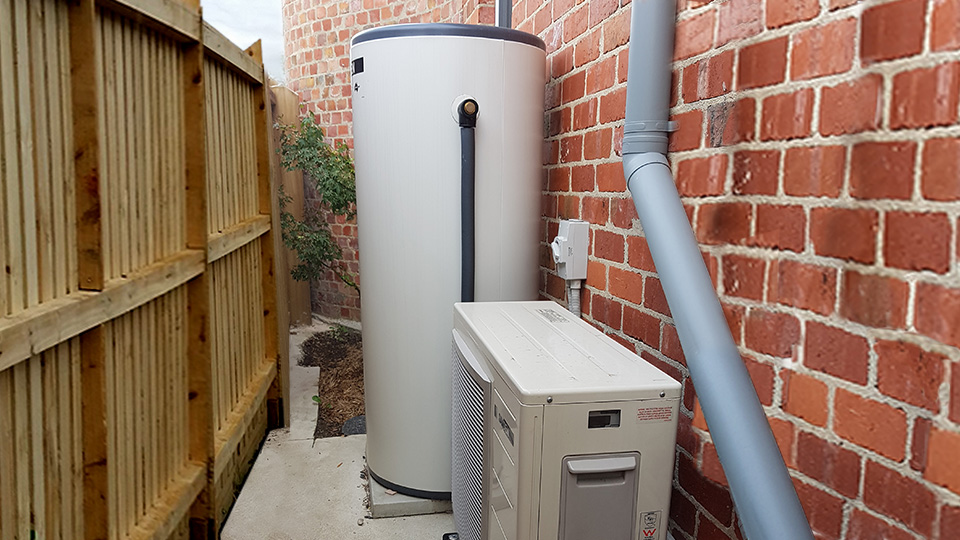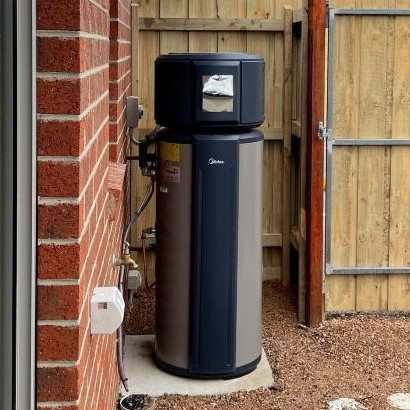HEAT PUMP HOT WATER Units — de-mystified:
What type of heat-pump do you need?
There are essentially two types of heat-pump hot water (HPHWS) units available.
I. A “split” arrangement has a water storage cylinder as one part, and a fan coil unit (like the outdoor unit for a split air-con) as a separate part. See photo below. The water storage cylinder stands close to the fan coil unit, so it takes up a bit of room. Typically the footprint is 1500mm x 600mm, plus allow another 500mm in front of the fan-coil unit for air movement from the fan.
II. An “integrated” unit has the fan coil bits stacked on top of the water storage cylinder (vertical arrangement), so it has a smaller footprint and is thus more suited to smaller or confined areas. It is probably best to have the unit positioned away from the wall a little for air movement. See photo at top.

Efficiency
Heat-pump hot water units operate by concentrating the heat in the outside air (even if it is quite cold) and pushing (pumping) it into your hot water tank. It only takes about a quarter of the energy in the operation of pushing this heat into the heated water (compared to the actual heat energy in the heated water). Depending on the design, the efficiency of its operation can vary. You might come across terms like Coefficient of Performance (COP) for rating the efficiency.
Noise considerations
Consider your neighbour. This type of equipment requires a fan to move a volume of air for correct operation and just like an air conditioner there is a some fan noise generated and, just like air conditioners, there are very quiet ones and others that are not so quiet.
If the preferred location for your HPHWS is very close to a neighbour’s bedroom window you might want to give quiet operation a priority when making your selection or consider moving it further away from a bedroom window. The noise figures are quoted in units of decibels (dB) and a low figure is around 40 to 45 dB.
Operating times
If you have a solar PV system on your roof you may want to run the HPHWS at a time when the sun is shining strongly i.e. after 11am, as this will provide the lowest cost of operation of your hot water system.
If you don’t have solar you might prefer to run the unit at night to take advantage of off-peak electricity tariffs. Generally, the off-peak period applies from 10pm to 7am week days, and all other times are ‘shoulder’ or ‘peak’. If possible, it is best not to have the unit running between 2am and 5am when disturbance might be more of an issue.
Each brand of system will have a timer function which can be set by the user or the installer to your requirements.
Tank size, and material
The storage tank should be well insulated to minimise heat losses but it should also be no bigger than required for the number of people in the house. A larger tank can add to the running costs for the system. For only one or two occupants the smaller tank sizes around 150-180 litres would be preferred. Tanks of 250 litres would be suitable for 3-5 people and 315 litre tanks are available large families.
For longest life, a stainless-steel storage tank is recommended which comes with a small cost increase. Other tank materials may come with a 5-year warranty but buyers should check if an anode is required to be replaced at intervals to minimise corrosion.
Refrigerant
A variety of refrigerant fluids are used by the various HPHWS manufacturers. Be aware that some refrigerants are due to be withdrawn in the next few years including refrigerant R134A. All refrigerants can be compared by their global warming potential (GWP) rating.
Refrigerants include R744 carbon dioxide (GWP = 1.0), R290 Propane (GWP=3.0), R600 Butane (GWP=4.0), R134A hydrofluorocarbon (GWP= 1,430), R134A is being phased out.
Getting Quotes:
Being prepared ahead of time with quotes is a good position to be in for when your existing Hot Water unit fails. Many people also find that having done the investigation and preparation of obtaining quotes that they are ready to proceed with the replacement and avoid the disruption in the event of the existing unit un-expectedly failing.
Getting the install done – tips
Choose the size and type of HPHWS to meet your situation and needs, including family size and the hot water unit location. Install your system close to where you’ll use most hot water, such as near the kitchen, bathroom and laundry (remembering the potential noise issue).
Get two or three Quotes. The Quotes should be inclusive of government rebates, with their quoted price to you net of the rebate they will process (you will effectively assign the rebate to them). Generally, it makes sense to have just the one installer manage the job, including the electrical work as well as the plumbing work.
Ensure the installation contractor insulates all hot water pipes and all fittings attached to the storage tank. Plumbing and electrical work must be done by qualified contractors and certificates of compliance must be provided to you after install.
Links:
7 Best Heat Pump Hot Water System Reviews [2023 Update] (enviro-friendly.com)
Compare water heating running costs | Sustainability Victoria

